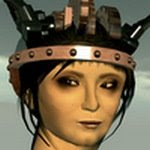Cao Fei (aka China Tracy in Second Life) is one of six finalists for the 2010 Hugo Boss award. The $100,000 prize is presented every other year to “the artist (or group of artists) working in any medium, anywhere in the world” for making the most important contribution to contemporary art.
In Second Life, we know her as the artist who conceived and produced the four sim/islands work collectively known as RMB City, and also for her 3-part i.Mirror machinima, a documentary shot in Second Life and presented at the 52nd Venice Biennale 2007.
This is a second blogpost in a two-part series we are publishing today. The first, "Wherein I finally love Cao Fei's RMB City," can be found here.
These days, it is almost impossible to pick up an art journal, read an art blog, or watch a TV documentary on the arts without hearing about Cao's Second Life persona, China Tracy, the pig-tailed avatar that looks to be a cross between a medieval dragon slayer and a space-age bot girl. This global fawning is not without merit. As PBS' Art:21 points out in its recent episode Fantasy and Contemporary Art, Cao "reflects the fluidity of a world in which cultures have mixed and diverged in rapid evolution. Her video installations and new media works explore perception and reality in places as diverse as a Chinese factory and the virtual world of Second Life."
Now that I've confessed (in the preceding blogpost) that I'm late to the China Tracy fan club, I can also say that I've been making up for lost time by learning considerably more about the artist. Soon after my epiphany and subsequent appreciation of RMB City, I sent Cao nine questions, and I didn't pull any punches, either.
B. Tizzy: 如果让你说出你事业中最关键的时刻,它对你选择从事现在的工作起过至关重要的作用,你觉得是什么时候?为什么?
If you were to identify the most pivotal moment in your career; that moment that most shaped what you are doing now, what would it be and why?
Cao Fei: 我创作的发展旅程是一个自然发展和逐渐过渡变化的过程,没有突然的转折点,没有什么重大时刻,它是一个循序渐进的、对这个世界、包括自己的人生的一个慢慢堆积、感悟、理解的过程。
My work has developed along a natural and gradual trajectory. There haven't been any sudden turning points or significant moments. It's been a gradual progression and a process of accumulation, inspiration and understanding of the world, including my own life.
Shot entirely in-world at RMB City, this video is by Lainy Voom, with writing by Wagner James Au (aka Hamlet Au)
B. Tizzy: 你所从事的工作是从什么时候开始有全球性视野的?你是有意决定这样做的吗?
At what point did your work take on a global aspect, and was it a conscious decision?
Cao Fei: 生活在今天的中国,每个个体都不能避免被卷入这全球化的运动,都不能对我们身边的激烈变迁视而不见,我只是在用自己的方式记录、表达我对身边这些变化的深切感受。这是个身不由己的时代,时代会迫使你作出一定回应。
No living being in contemporary China can avoid globalization or turn a blind eye to its acute changes. I am merely using my own method to document and express my honest feelings with regards to the changes that surround me. 
![]()

B. Tizzy: 你是使用什么软件建立起了第一个人民城寨••••••是我们一开始在Youtube见到的那个吗?你是先做好了它然后才发现第二人生的,还是你那时就已经是虚拟世界居民了?
What software did you use to create the first RMB City... the one we first saw on Youtube? Did you make it first and then discover Second Life, or had you already become a virtual world resident?
Cao Fei: 我是在2007年1月成为虚拟世界居民,然后用了半年时间在虚拟世界旅行,拍摄了i.Mirror,紧接着,就有了建造人民城寨的构想,并开始用3D Max软件把城市基本构想勾勒出来,也就是后来你们在youtube看到的video: RMB City Planning (2007)。
I became a virtual world resident in January 2007. Then I spent half a year traveling in the virtual world and filming i.Mirror. Soon after, I had the idea of building RMB City and started building the basic blueprint with 3ds Max software. The result is the youtube video which you have seen: RMB City Planning (2007).
RMB City on Cao Fei's computer
RMB City in Second Life
B. Tizzy: 人民城寨备受现实世界艺术评论家以及博物馆和媒体的推崇,但却未得到第二人生居民的充分赏识。我们是应该解决这个问题,还是转向只针对现实世界(Real World)来做这个项目?
RMB City is acclaimed by Real World art critics, museum and media, but under-appreciated by Second Life residents. Does that matter moving forward, or was this project intended for Real Life?
Cao Fei: 我想,这是个悖论,我们总是很难做到周全而完美。要得到更多第二人生居民的赏识,我还需要做很多我不胜任的工作,如如何竭力保持社团的黏性,如何不断组织虚拟居民喜闻乐见的活动,如何发展会员等等。人民城寨项目是一个艺术项目,它具有在当代文化概念上的指涉,以及在这个框架下的实验价值,它不一定要具有虚拟社会内的普罗大众的功能,而做一个在虚拟社会里很pop的地点也不是我的初衷,我更原意把它当作一个超越对固定理解之外的“现场”,不刻意针对现实世界或虚拟社群,甚至忘记其的虚拟特性和现实依据,它是一个模糊的、开放的、不被彰显定义的地带,一切事物都可被卷入而最终不再成为他们的原本。而它作为一个具有沟通现实世界特性的项目,迂回在两个世界之间,这也可能是其他虚拟城市/项目所缺乏的。
I think this is a paradox. It's always difficult to create a perfect thing. To win the appreciation of more Second Life residents, I would have to do a lot of work that I am incapable of doing, such as maintaining a tight-knit community, organizing regular activities that interest Second Life residents, develop membership, and so forth. RMB City is an art project and contains references to contemporary cultural concepts. Given the experimental framework, it doesn't have to serve the proletarian function of virtual societies.
Furthermore, it was not my intent to create a very pop place within the virtual world. I would rather treat it as a "site" that transcends fixed interpretations. I don't purposely address the real world or virtual groups and even forget its virtual characteristics and foundation in reality. It is an ambiguous, open zone that eludes definition. Things get pulled in and may never revert to their original form again. This project channels real world characteristics and rests outside of two worlds, something that perhaps other virtual cities/projects lack.
B. Tizzy: 人民城寨被认为是具有讽刺意味符号集合的典型。事实如此吗?还是你有别的看法?
RMB City is typically described as a satirical collection of icons. Is that what it is or is there something else?
Cao Fei: 除了讽刺,还有赞美,甚至歌颂,但这都不是它的全部。它还有失落、忧郁,以及回忆和怀旧。作为一个文化意义上的“空间”,它具有研究、讨论、实验、实践的特性。作为一个心灵景观,它无时无刻都在上演流动的戏剧。作为一个折射当代中国的镜像,它有着后现代的狂欢和梦呓,同时有着反省与自悟。当然也有包括其他城市都共同具有的特性 ——“虚空”。
There is satire, but also praise and even admiration. But this does not describe it in its entirety. There is also loss, melancholy, memory and nostalgia. As a cultural "space," it lends itself to research, discussion, experimentation and realization. As a spiritual site, it is a constant, ongoing drama. As a reflection of contemporary China, it has the revelry and balderdash of postmodernism. At the same time, it is introspective and self-perceptive. Of course it also includes the one trait that all cities have – “emptiness.”
B. Tizzy: 飞机撞上大楼的景象让美国人见了就火冒三丈,什么促使你把它带进了人民城寨?
The image of a plane flying into buildings is nauseating for Americans. What compelled you to introduce that to RMB City?
Cao Fei: 我想这个问题所表现出来的先入为主是文化差异的表现,或者是差异所导致的联想。我们城市里的飞机不是撞上大楼,而是卡在密集的建筑之间,中国急剧的城市化导致建筑密度大幅增加,不断外扩的CBD淹没我们的天际线,逐渐的,我们只能在楼宇和城中村的缝隙间看到飞机越过天空,而在RMB City,飞机一旦掠过城市,就再也飞不出去了,永远地卡在这个溢出的都市中。
I think immediately of cultural differences, or rather the associations that form as a result of difference. The planes in our city do not crash into buildings; they are caught between densely concentrated architecture. China's rapid urbanization has resulted in a building boom. The constantly expanding CBD has submerged our skyline. Eventually, we will only be able to see planes from inside buildings or gaps within the city. When a plane flies over RMB City, it can never leave, and is forever trapped inside the overflowing city.
B. Tizzy: 人民城寨有什么需要发掘的秘密吗?有什么是第二人生居民不能理解,或是觉得不值得关注的?
Are there any secrets that need discovering at RMB City? What haven't Second Life residents understood or picked out that is noteworthy?
Cao Fei: 人民城寨从来没有什么秘密,也没有什么需要去发掘的,去慢慢体味它可能更适合,或者你尝试放弃飞翔去徒步漫游,再或者飞到城市之颠或无限接近城市的边缘。喜欢一个城市与否,和你喜欢某本书一样,有人喜欢畅销书,有人喜欢冷门的诗歌集,大部分人喜欢流行乐,还是有人喜欢偏门的噪音,这就是趣味和选择,我们很高兴人民城寨能成为另外一种选择或者众选择之一。欢迎大家,也许,有一天你会爱上它,或者短短的一次性旅程能让你记忆深刻,以至于它在某天突然消失了你恍然间感到隐隐不舍。
RMB City has never had any secrets or things waiting to be unearthed. It's probably more appropriate to slowly experience it yourself; you can give up flying and walk around or fly to a high point in the city or one of the countless peripheral points on the outskirts. Whether or not you like a city, is the same as whether or not you like a book. Some people like best-sellers and some prefer obscure chapbooks; most people like pop music, but still some prefer experimental sound This has to do with preference and choice. We are very happy that RMB City can be an option or one of many options.
B. Tizzy: 请再给我们介绍一些关于人民城寨新古根海姆大楼的情况。
Tell us more about the new Guggenheim building at RMB City. 
Cao Fei: I have been invited by the Guggenheim Museum to participate in the 2010 exhibit: “Contemplating the Void: Interventions in the Guggenheim Museum Rotunda” for the museum's 50th anniversary. The Guggenheim invited approximately 250 artists, architects and designers to imagine their dream intervention in Frank Lloyd Wright’s rotunda.
Therefore, I built a virtual Guggenheim that can transform into an "ox horn." I chose an ox horn because of an ancient Buddhist story. Second Life is an intangible non-physical space that has its conceptual foundations rooted in the virtual dimension. As such, our perception and comprehension of this space is largely reliant on visuals and psychological impact. Within Second Life's RMB City, the Guggenheim Museum is transformed into an ox horn floating in the city's sky, like a manifestation of the notion of "nothingness" as depicted in the story of Milarepa Thera and the horn, and the parallel relationships that the virtual and real worlds possess towards "nothingness." On some level, it is also akin to the idea of inherent harmony amongst disparate entities within Buddhist cosmology.
Director: Cao Fei (SL: China Tracy)
Concept/Script: Huang He (SL: QueenShoe Voom)
Translation: Venus Lau (SL: Nokan Vlodovic)
Project Manager: Samantha Culp (SL: Miniature Tigerpaw)
Project Coordinator: Mengxian Li (SL: Ume Freiman)
Engineer of Fengshui Project: Sinewave
Camera / Editing: Avatrian
Co-produced by Kaaitheater, Festival PERFORMATIK 09, Brussels, Belgium
B. Tizzy: 放眼未来,你对未来人民城寨合作在艺术以及艺术家发面有什么期望?
Moving forward, what are you looking for in art and artists for future RMB City collaborations?
Cao Fei: 人民城寨它是一个持续时间为两年的艺术项目,接下来还有1年的时间就要结束了。人民城寨是一个用来运转的作品,它不仅仅是用来看和游览的,它鼓励和邀请人们参与,对系统建设性地提出问题与假设,并向更开放的方向发展。称之为:行动的,自由的,系统之间的。
RMB City is a two-year project. There is one more year before it ends. RMB City is a revolving piece and not just for viewing or visiting. We encourage and invite people to participate and raise questions and hypotheses about the system structure so we can develop a more open(ly and) in an even more open direction. It should be considered: moving, free, seamless between systems.
Many thanks to Philana Woo for making this interview possible with her English to Chinese/Chinese to English translations, and to Honora Shea of Vitamin Creative Space for making the arrangements. I also especially want to thank Cao Fei for graciously agreeing to this interview at a time when she is busy caring for her baby son Cowboy Lim, born in March of this year, in addition to working on her many projects within and outside of Second Life.
Friday, October 23, 2009
An interview in Chinese and English with virtual superstar Cao Fei - Will you be the next artist showing at RMB City?
Posted by
Bettina Tizzy
at
4:29 PM
![]()
Labels: Art:21, Cao Fei, China Tracy, Guggenheim, Hamlet Au, i.mirror, Lainy Voom, machinima, Not Possible IRL, NPIRL, Philana Woo, RMB City, virtual arts









3 comments:
I too found RMB City unsettling at first. I was both fascinated and puzzled by it upon my 1st visit. At first I related to it as collage… then got distracted in it… then loved what I recognized and scratched my head at what I didn’t. I can remember exclaiming to my fellow traveler how empty it was… a common trait of many cool places in Second Life. I see now that emptiness was in fact critical to my experience and reaction to the work.
Thank you Bettina for such an honest re-evaluation of RMB and thank you Cao Fei for creating it and taking the time to discuss it with us (and thank you to all who helped connect them); it was an appreciated provocation of my own thoughts.
Cao Fei: "As a reflection of contemporary China, it has the revelry and balderdash of postmodernism."
I teleported to RMB City for the first time today. Now I am wondering how the Petronas Twin Towers ended up in a reflection of contemporary China.
Maybe the message is that western audiences can't tell the difference between China and the rest of Asia. Or the difference between art and walmart.
or perhaps it's a commentary on the centuries old presence of Chinese in Malaysia - now 7,000,000 people - who have historically placed a major role at the top of key Malaysia institutions.
Post a Comment